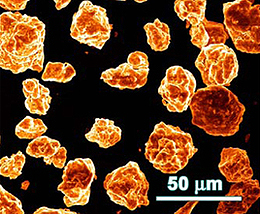MgZn系金属ガラス粉末による優れたアゾ色素分解能力
Excellent capability in degrading azo dyes by MgZn-based metallic glass powders
2012年5月23日 Scientific Reports 2 : 418 doi: 10.1038/srep00418

金属ガラスの新たな機能的応用が乏しいため、この魅力的な材料のさらなる開発が阻まれている。我々は本論文で、MgZn系金属ガラス粉末に、典型的な水質汚染有機物質であるアゾ色素を分解する優れた機能的能力があることを初めて報告する。MgZn系金属ガラス粉末のアゾ色素分解効率は、市販の結晶Fe粉末の約1000倍であり、Mg-Zn合金結晶の約20倍である。このアモルファスMg系合金にはZnが多く含まれているので、結晶Mgと比較して、水中での腐食耐性およびアゾ色素との反応効率を高くできる。また、MgZn系金属ガラス粉末は、複雑な環境条件下でも高い反応効率を維持している。我々の研究は、金属ガラスの機能的応用に向けて新たな機会を開くものである。
- 東北大学原子分子材料科学高等研究機構(WPI-AIMR)
- 東北大学 金属材料研究所
- ウィスコンシン大学マディソン校(米国)
The lack of new functional applications for metallic glasses hampers further development of these fascinating materials. In this letter, we report for the first time that the MgZn-based metallic glass powders have excellent functional ability in degrading azo dyes which are typical organic water pollutants. Their azo dye degradation efficiency is about 1000 times higher than that of commercial crystalline Fe powders, and 20 times higher than the Mg-Zn alloy crystalline counterparts. The high Zn content in the amorphous Mg-based alloy enables a greater corrosion resistance in water and higher reaction efficiency with azo dye compared to crystalline Mg. Even under complex environmental conditions, the MgZn-based metallic glass powders retain high reaction efficiency. Our work opens up a new opportunity for functional applications of metallic glasses.

